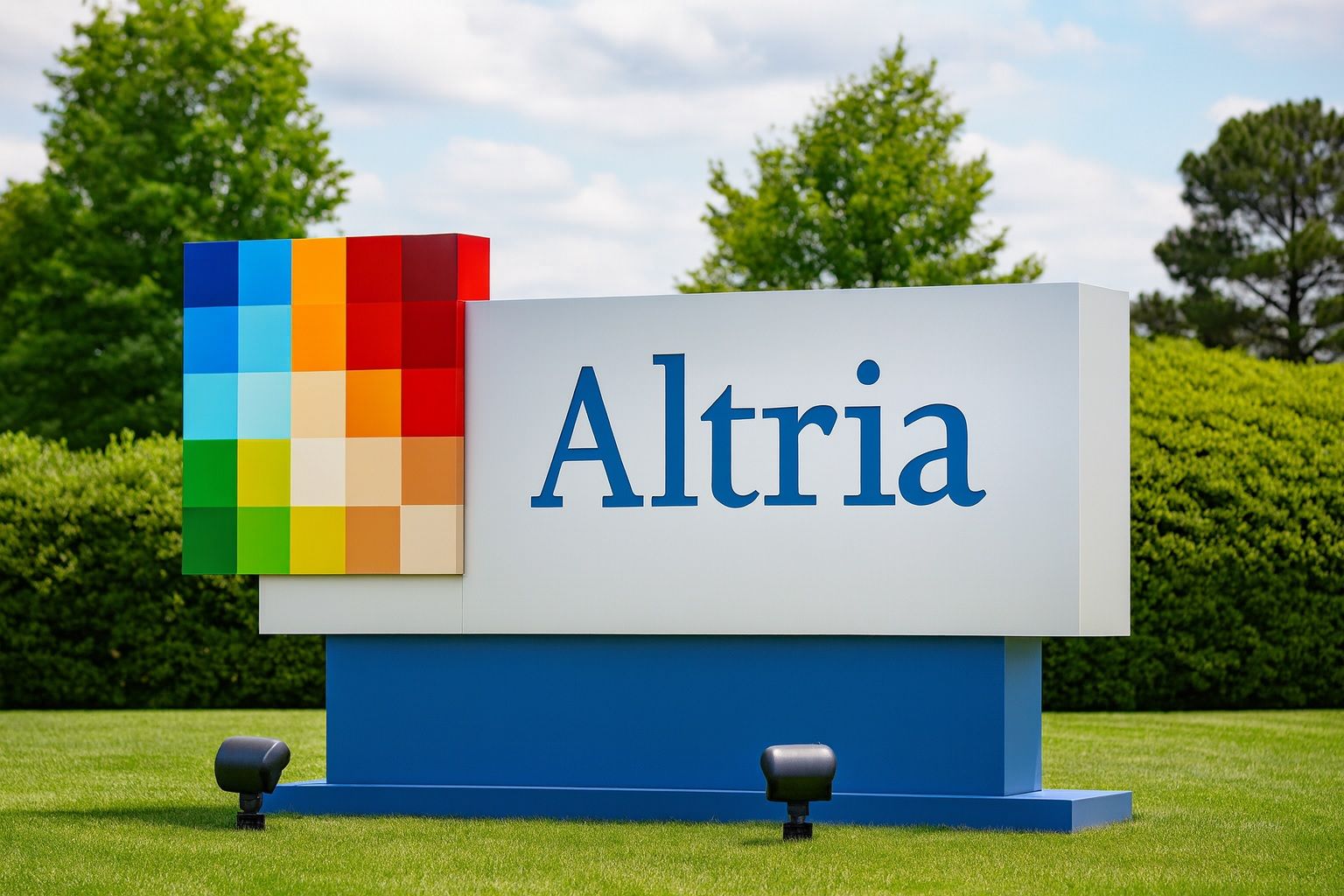- Earnings and Stock Dip: Altria Group (NYSE: MO) delivered mixed third-quarter results, meeting profit estimates but seeing a larger revenue drop than expected. Shares fell nearly 4% in pre-market trading on the report [1] and have pulled back to the low-$60s, roughly 10% below recent 52-week highs [2]. Despite the dip, MO stock remains up over 20% in 2025, outpacing the broader market [3].
- Revenue Down, EPS In-Line: Q3 net revenues declined ~3% year-on-year to $6.07 billion, reflecting ongoing cigarette volume declines [4]. Adjusted EPS came in at $1.45, up 3.6% and matching Wall Street’s forecast [5]. Altria narrowed its full-year outlook, raising the low end of 2025 earnings guidance to $5.37–$5.45 (3.5–5.0% annual growth) [6]. The midpoint ~$5.41 is slightly below analyst consensus ($5.44) [7], signaling a “tepid” profit forecast amid sluggish tobacco demand [8].
- $2 Billion Buyback Boost: Altria’s board doubled its share repurchase program from $1 billion to $2 billion (through end of 2026) to return more cash to shareholders [9]. The company also notched its 60th annual dividend hike in August, lifting the quarterly payout to $1.02 per share [10]. At the current stock price that’s about a 7–8% yield, making Altria one of the highest-yielding dividend stocks in the S&P 500 [11].
- Tobacco Slump & Alternatives: Cigarette sales continue to decline – Marlboro volumes dropped again, with smokeable revenue down 2.8% in Q3 (to $5.39 B) and oral tobacco revenue (mainly on! nicotine pouches) down 4.6% (to $689 M) [12]. Altria’s push beyond smoking has hit setbacks: a patent lawsuit forced it to halt sales of NJOY e-cigarettes earlier this year, wiping out a key vaping product until at least 2026 [13]. Unregulated disposable vapes from overseas have flooded the U.S. market, undercutting regulated brands [14]. On! nicotine pouches remain a bright spot with growth, but aren’t yet offsetting cigarette declines and the NJOY gap [15].
- Regulatory & Industry Signals: In a positive development, the U.S. FDA moved to fast-track review of nicotine pouches amid White House pressure to promote smoking alternatives. Altria, whose on! pouches are in the pilot program, called the FDA’s approach “encouraging” for harm reduction [16]. Rival Philip Morris International leads the U.S. pouch market with its Zyn brand (40–80% shipment growth each quarter since 2023) [17], putting pressure on Altria and BAT’s Reynolds to catch up. Broader FDA proposals – from potential menthol cigarette bans to nicotine caps – loom as wildcard risks for the industry.
- Analyst Views Mixed: Wall Street is divided on MO’s prospects. Goldman Sachs recently raised its price target from $65 to $72 and reiterated a Buy rating, seeing roughly 10% upside [18]. UBS and Bank of America also issued upbeat revisions over the summer [19]. However, most analysts remain cautious: according to MarketBeat, Altria carries a consensus “Hold” with 4 Buy, 5 Hold, and 2 Sell ratings, and an average 12-month target around $62 [20] (slightly below the latest price). Quant models see value – one Joel Greenblatt “Magic Formula” screen gave MO a 100% score, deeming it a “notable value play” due to its high earnings yield and returns on capital [21].
- Investor Sentiment & Outlook: Income-focused investors continue to flock to Altria’s hefty dividend. As one analysis noted, “Altria continues to provide… a safe haven, [with] alluring (and sustainable) yield and impressive share performance” [22]. In the near term, the company’s own outlook implies only modest growth, and management admits headwinds as U.S. smokers decline. Longer-term, forecasts call for relatively flat performance – 24/7 Wall St. projects MO’s stock will be roughly unchanged by 2030 (around mid-$60s) [23] – meaning the bulk of returns may come from those rich dividends. Still, with a recession-resistant core business and ongoing buybacks, Altria offers stability and cash flow that many investors prize if not explosive upside.
MO Stock Slides on Mixed Earnings
Altria’s third-quarter earnings highlight the tobacco giant’s balancing act between resilient profits and declining cigarette usage. The company reported an adjusted Q3 profit of $1.45 per share, a 3.6% increase year-on-year and exactly in line with analyst expectations [24]. However, revenue fell more than anticipated – net revenues came in at $6.07 billion, down ~3% from a year ago [25]. This topline drop exceeded Wall Street’s forecasts and underscored weaker cigarette volumes. The mixed results put immediate pressure on MO stock, which fell about 4% ahead of Thursday’s open on the news [26].
Even after the post-earnings dip, Altria’s stock is still up significantly in 2025. Shares had rallied into the mid-$60s before earnings – at one point nearing a 52-week high around $68.60 [27] – fueled by investor appetite for its defensive profile and dividend. At ~$62 per share after Q3, MO remains over 20% higher year-to-date [28], greatly outperforming the S&P 500. In fact, the Dividend King’s 25% YTD gain through late October suggests that many investors had already bet on Altria as a high-yield haven [29]. The latest pullback trims those gains but also brings the stock’s valuation back toward a historically cheap ~12× earnings [30].
Management acknowledged both the successes and challenges in the quarter. “Altria continued to build significant momentum in the third quarter with exciting progress across our businesses,” said CEO Billy Gifford, citing resilient core tobacco operations and advancements in the company’s “smoke-free portfolio” [31]. At the same time, headwinds are evident in the numbers: smokable product revenue dropped 2.8% to $5.39 billion, and even the oral tobacco segment (including on! nicotine pouches) saw sales fall 4.6% to $689 million [32]. Those declines reflect an accelerating industry trend of volume contraction, partly offset by price hikes. Altria has managed to keep earnings growing modestly through aggressive cost cuts and higher pricing on Marlboro, but the Q3 revenue miss shows the limits of that strategy as cigarette demand wanes.
For the full year, Altria trimmed its range but essentially reaffirmed expectations of modest growth. The company narrowed 2025 adjusted EPS guidance to $5.37–$5.45 (from a prior $5.33–$5.45 range, analysts noted) – effectively raising the floor by 4¢ [33]. This implies 3.5%–5.0% growth over last year’s $5.19 base [34]. Notably, the new midpoint of ~$5.41 is just below the $5.44 consensus estimate [35], a point Reuters highlighted as a sign of “tepid” outlook relative to the Street [36]. Altria’s guidance tweak suggests that while its pricing power and cost discipline can deliver earnings within targets, management is hardly expecting a surge in business in Q4. In fact, the company cited “sluggish tobacco demand” in lowering its internal forecasts earlier in the year [37]. With that cautious tone, some investors took profits after the long 2025 run-up, leading to the recent share price slip.
Dividend Giant: 60th Increase and Massive Yield
One area where Altria continues to shine is shareholder returns. True to its reputation as an income machine, Altria once again boosted its dividend this year – marking the 60th dividend increase in 56 years [38]. In August, the quarterly payout was raised to $1.02 per share, keeping Altria’s status as a “Dividend King” intact. For investors, that annualizes to $4.08 per share, which at the current stock price yields roughly 6.5%–7.5%. In fact, just a couple weeks ago Altria was offering around a 7.8% dividend yield according to analysts [39] – an eye-popping figure in a world of 5% Treasury rates. This ultra-high yield firmly positions MO as one of the top-yielding stocks in the S&P 500, and it comes with a strong track record: Altria has increased its dividend for over 50 consecutive years.
Management emphasizes that the dividend is sustainable, backed by a target payout ratio of around 80% of adjusted earnings. With the updated guidance, Altria’s 2025 earnings should land around $5.40, meaning the $4.08 dividend is ~75% of profits – in line with that policy. “We also continue to demonstrate our commitment to returning value to our shareholders,” CEO Billy Gifford noted, highlighting the August dividend hike as a key milestone [40]. Income investors often cite Altria as a cornerstone holding; its dividend alone provides a hefty income stream, and the company’s stable cash flows from a decades-old Marlboro franchise underpin those payouts.
Beyond dividends, Altria is accelerating returns through stock buybacks. On October 29, the company’s Board authorized expanding the existing share repurchase program to $2 billion (from $1 billion previously) [41]. The buybacks are planned through December 31, 2026, giving management flexibility to retire shares over the next year at what they likely view as undervalued prices. At the midpoint, $2 billion could retire roughly 5% of Altria’s outstanding shares at current valuations. Actual repurchases will depend on “marketplace conditions and other factors” and remain at the Board’s discretion [42]. However, the message is clear: Altria is doubling down on returning cash.
This newly expanded buyback comes on top of significant repurchases already executed. In the first half of 2025, Altria bought back 10.4 million shares for $600 million (average price ~$57.71) and had $400 million remaining under the old $1B authorization [43]. Now, with the authorization bumped up by an additional $1 billion, the company has plenty of dry powder to support the stock or take advantage of any weakness. The timing is favorable – with shares in the low-$60s, Altria can effectively “yield” over 7% on its buyback (reducing shares to save future dividends). Combined with the cash dividend, total shareholder yield (dividends + buybacks) on MO may approach an enormous ~10% annually at recent prices. Few blue chips offer such a payout, which is why many investors see Altria as a cash cow for portfolios.
Tobacco Troubles: Slumping Volumes and Product Setbacks
Underneath the robust shareholder rewards, Altria faces undeniable business challenges. Smoking rates in the U.S. have been declining for decades, and that secular downtrend is eroding Altria’s core revenue. In the third quarter, cigarette shipment volumes fell once again, continuing a pattern of mid-single-digit percentage declines. Altria managed to limit revenue slippage to 2.8% for smokeables by raising prices [44] – effectively extracting more profit from a shrinking pool of smokers. But over the long term, this strategy has limits, and the company is racing to develop “smoke-free” alternatives to prop up future sales.
So far, Altria’s pivot beyond combustible tobacco has been bumpy. Its past investments in vaping famously turned sour: a $12.8 billion stake in JUUL Labs was largely written off after JUUL’s meteoric rise was followed by regulatory crackdowns and legal woes. More recently, Altria spent $2.75 billion in 2023 to buy NJOY Holdings, securing a portfolio of FDA-authorized e-cigarette products it hoped to scale. That plan hit an unexpected roadblock this year when a patent dispute (with R.J. Reynolds’ Vuse brand) forced NJOY Ace devices off the market [45]. In Altria’s words, its smoke-free strategy “suffered another blow” as NJOY sales were paused and won’t likely resume until 2026 pending litigation [46]. Essentially, Altria paid billions for a revenue stream that is now on hold, ceding more ground to competitors in the fast-growing vape category.
Meanwhile, a flood of unauthorized disposable vapes from overseas (often China) has captured U.S. market share, operating in a grey area of enforcement. These cheap, flavor-packed devices – exemplified by brands like Elf Bar – have siphoned off consumer demand, hurting both Altria’s NJOY and competitors’ legal products. Altria and other tobacco companies have been lobbying authorities to crack down on illicit vape imports [47] [48], but the challenge remains significant. The company’s latest earnings call echoed these concerns, noting that “unregulated flavored disposable e-vapor products” are proliferating and impacting volumes [49].
On a brighter note, Altria’s foray into nicotine pouches is showing promise. The company’s on! brand (acquired through Helix Innovations in 2019) has been steadily growing its share of the smoke-free oral nicotine market. These tobacco-free pouches cater to consumers seeking alternatives to traditional chew or dip, as well as smokers looking to quit cigarettes. Altria’s Q3 results confirm on! volumes are rising, though revenue slipped 4.6% – partly due to promotional investments and a high bar from last year [50]. Executives remain optimistic about on!’s trajectory, especially if regulatory moves favor licensed products over the many copycat nicotine pouches being sold without FDA clearance.
Crucially, the regulatory winds may be shifting in Altria’s favor for pouches. In a late October exclusive, Reuters reported that the FDA is launching a pilot program to speed up reviews of four companies’ nicotine pouches, including Altria’s on! and on! Plus products [51] [52]. Under pressure from the White House, the agency aims to finalize decisions by December on these pending applications [53] – a process that normally could take years. If Altria’s on! pouches get the FDA greenlight, it could solidify the brand’s legitimacy and remove “questions over their legality” that have hampered marketing [54]. “[This] approach [is] encouraging and a positive step for harm reduction,” Altria said of the FDA’s fast-track plan [55]. In other words, Altria sees an opportunity to compete more effectively when a level playing field is enforced.
Still, competition in nicotine alternatives is fierce. Philip Morris International (PM) – Altria’s former sister company, which sells Marlboro abroad – has surged ahead in pouches after its 2022 acquisition of Swedish Match. PMI’s Zyn nicotine pouches dominate the U.S. market, boasting “explosive growth” of 40–80% in shipments each quarter since early 2023 [56]. That kind of growth has quickly made Zyn a top profit driver for PMI, and it highlights how far Altria must go to catch up. Likewise, British American Tobacco’s Reynolds American unit (maker of Camel) is pushing Velo nicotine pouches and Vuse e-cigs, further crowding the field. Altria is essentially in a race to reinvent itself for a post-cigarette era, investing in heated tobacco, oral nicotine, and even cannabis (via its Cronos stake) to find the next pillar of revenue. Each of these efforts comes with execution risk, and as Q3 showed, they have yet to fully replace the shrinking cigarette income.
Beyond marketplace competition, Altria and its peers face looming regulatory hurdles that could radically reshape the industry. The U.S. FDA has floated proposals to mandate very low nicotine levels in cigarettes (to make them minimally addictive) and to ban menthol flavoring in cigarettes and cigars. Both measures are still in process – they’ve drawn strong support from public health groups and equally strong opposition from tobacco companies. Should they take effect in coming years, cigarette makers could see an accelerated decline in sales or a forced pivot to new products. Altria has been active in submitting comments and preparing contingency plans (like developing non-menthol alternatives and expanding its portfolio of nicotine-delivery products). While these regulatory changes were not implemented as of 2025, they represent potential “game changers” for the long-term outlook. In the meantime, Altria’s strategy remains to diversify within the nicotine category and advocate for “science-based, harm reduction” policies that favor products like pouches and heat-not-burn devices over combustible cigarettes [57] [58].
Wall Street Forecasts: Value Play or Stagnant Smoke?
With Altria’s fundamentals in flux, analysts have differing takes on the stock. The current consensus rating sits around a Hold, reflecting both the bull and bear cases. On the bullish side, some see Altria as deeply undervalued – a stable cash-generating business priced at a bargain multiple, with an almost 8% yield that is hard to find elsewhere. Notably, Goldman Sachs in early October reaffirmed its optimism, raising its price target to $72 (from $65) and maintaining a Buy rating [59]. Goldman’s target implies nearly 10% upside from recent trading levels, on top of the hefty dividend. Similarly, Bank of America in August boosted its target to $72 (Buy) and UBS upgraded MO from Sell to Neutral, lifting its target to $59 (after the stock’s strong run) [60]. Marketbeat.com tracking shows at least four firms rate Altria a Buy, citing its defensive earnings and shareholder yields.
However, the majority of coverage is more cautious, highlighting limited growth prospects. According to MarketBeat’s compilation, Altria has five Hold ratings and two Sells alongside those buys [61]. The average 12-month price target is about $62 [62] – essentially where the stock trades now, suggesting minimal expected upside. This camp of analysts acknowledges Altria’s strengths (strong brands, pricing power, dividends) but worries that shrinking cigarette volumes and sputtering alternatives will cap any earnings or share price growth. In their view, Altria may tread water: generating enough profit to keep paying dividends, but not a lot more. Indeed, one recent forecast from 24/7 Wall St. estimates Altria’s stock could end the decade roughly flat around $65 per share [63]. Their model sees earnings per share creeping up to ~$6.05 by 2030, but with the price/earnings multiple possibly contracting as the tobacco business slowly winds down [64]. That scenario implies investors would mainly be collecting the dividend yield for returns, not capital gains.
It’s worth noting that quantitative value screens have been flagging MO stock as a potential bargain. In mid-October, a Validea investment model based on Joel Greenblatt’s “Magic Formula” (which seeks stocks with high earnings yield and high return on capital) gave Altria a perfect 100% score and a “PASS” rating, indicating it ranks at the top as a value play under that framework [65]. The Magic Formula typically identifies companies that are both cheap and profitable, and Altria fits the bill with its low P/E and fat margins from its oligopolistic tobacco business. While such quant models don’t guarantee performance, they underscore a key point: MO’s valuation is low by historical standards. The stock’s forward P/E around 8× (ex-dividend) and ~12× on an operating basis [66] sits well below the S&P 500 average, reflecting investor skepticism. If Altria can stabilize earnings or find a new growth avenue, there is potential for multiple expansion. On the flip side, if earnings start to decline outright, even a low multiple can’t prevent a stock from drifting down.
Several analysts have pointed out that Altria’s risk/reward now skews on execution of its reduced-risk product strategy. “No longer the time to buy now,” cautioned one Seeking Alpha commentator, arguing that while the dividend is secure, the easy gains have been made during 2023’s rebound and the stock could stagnate in absence of positive catalysts [67]. Bears also raise the specter of future litigation or regulatory shocks that could hit Altria’s core business – from a sudden menthol ban to unfavorable tax changes or even an FDA mandate on nicotine content. Any of those could potentially jolt the financial outlook in a way not fully reflected in current estimates.
On balance, the Street seems to agree that Altria is a reliable income stock, but there is less agreement on whether it’s a great total return stock going forward. As evidence, the consensus one-year target of ~$62 implies essentially a flat performance, which is another way of saying the dividend (≈7% annually) would account for all expected return. Of course, individual calls vary: Stifel and Jefferies have been on the bearish end (Jefferies started coverage with an Underperform and $50 target) [68], whereas Weiss Ratings and others lean bullish (Weiss reiterated a “buy” in late September) [69]. This divergence stems from different assumptions about how steep the cigarette decline curve will be and how successful Altria’s non-combustible ventures can become.
Outlook: High Yield Haven – With Caveats
Looking ahead, Altria faces a classic high-yield stock dilemma: Can the company maintain its generous payout and slow growth indefinitely, or will something upset the apple cart? In the near term, the picture actually looks stable. Altria’s updated guidance and conservative management style suggest it will continue to churn out ~$8 billion in annual free cash flow, comfortably covering the ~$6.8 billion in yearly dividends. The expanded buyback authority provides a tool to support the stock or boost earnings-per-share by shrinking the float. And economic uncertainty (or market volatility) could even benefit MO, as investors often rotate into “defensive” stocks like tobacco when cyclicals falter. It’s telling that during the 2022–23 bear market, Altria held up well and kept raising its payout. One analysis even dubbed Altria “the stock to own when the market collapses,” given its resilience and steady cash returns in downturns [70].
Over the long term, however, Altria must execute a tricky transition. The company itself acknowledges a future “Moving Beyond Smoking.” It has made investments in next-generation products (from heated tobacco devices to nicotine pouches to cannabis via Cronos) to diversify its revenue. The timeline and payoff of these bets remain uncertain. For example, Altria expects NJOY’s e-vapor products to re-launch in 2026 pending legal resolution [71] – if successful, that could finally give it a credible vaping platform to compete with Juul, Vuse, and others. Likewise, if on! nicotine pouches gain FDA approval by year-end, Altria could scale up marketing and distribution, potentially capturing more of the rapidly growing nicotine pouch category (projected to expand at ~5% CAGR globally through 2030 [72]).
Investors will be watching early 2026 for signs that these smoke-free initiatives can start moving the needle. By that time, Altria will also likely face whatever new rules FDA finalizes on cigarettes (e.g. menthol or nicotine caps), which could accelerate the volume decline but perhaps push more smokers toward the company’s alternative products. In a sense, Altria’s future cash flows might depend on successfully migrating smokers to its own non-combustible offerings rather than losing them to competitors or quitting entirely.
Analysts say the most likely scenario for Altria is to continue as a cash cow with slow erosion – a scenario in which it can still deliver respectable shareholder returns. Altria’s long history shows an ability to adapt pricing and operations to keep profits flowing even as smoking rates fall a few percent each year. Barring a shock regulation that upends that pattern overnight, the company could potentially extend its earnings “melt slowly, not melt down” trajectory well into the 2030s. If so, the dividend – currently yielding around 7% – will remain the main attraction, and periodic buybacks will boost the value of each remaining share.
For investors, the trade-off is clear: Altria offers a very high income and relative safety, but minimal growth. That makes it suitable for those seeking yield and stability (retirees, income funds, etc.), especially compared to riskier high-yield plays. It’s telling that 24/7 Wall St. projects Altria’s stock price in 2030 to be essentially where it is now [73]; in that outlook, an investor’s gain would mostly be the sum of dividends collected (which could be 30–40%+ of the initial investment over that period). If one reinvests those dividends, the returns compound more strongly, but the base business isn’t expected to do much more than inch forward.
Of course, if Altria surprises to the upside – say, a breakthrough in reduced-risk products or an acquisition that diversifies its portfolio – there could be capital appreciation on top of the yield. Some bulls argue that MO is undervalued and any stabilization of cigarette volumes or regulatory clarity on alternatives could lead to a re-rating higher. The stock’s low beta (~0.55) and defensive nature also make it a portfolio diversifier in volatile markets [74].
In summary, Altria Group today presents a compelling but nuanced case. It’s a cash-rich, dividend-paying powerhouse trading at a modest valuation, which in 2025 has delivered both income and stock price gains to investors. Yet its core business is gradually shrinking, and management is scrambling to build new revenue streams in a challenging regulatory landscape. The next few quarters will be pivotal in gauging how well Altria can execute its “smoke-free future” strategy. In the meantime, shareholders are being paid royally to wait. As one analyst put it, Altria is “historically reliable” and more than capable of weathering market downturns [75] – but whether it can grow meaningfully is the lingering question. For now, the stock’s nearly 8% dividend yield and expanded buybacks are front and center, making MO a standout in a yield-hungry market, albeit with the classic tobacco caveat: the clouds of declining smoking rates continue to hang overhead.
Sources: Altria Q3 2025 earnings press release and conference call; Business Wire/Altria investor relations [76] [77]; Reuters (Prerna Bedi/Emma Rumney) [78] [79] [80]; Reuters (Patrick Wingrove) [81] [82]; MarketBeat [83] [84]; TS2.tech market commentary [85] [86]; 24/7 Wall St. [87] [88].
References
1. www.reuters.com, 2. www.marketbeat.com, 3. 247wallst.com, 4. www.reuters.com, 5. www.reuters.com, 6. www.stocktitan.net, 7. www.reuters.com, 8. www.reuters.com, 9. www.stocktitan.net, 10. www.stocktitan.net, 11. ts2.tech, 12. www.reuters.com, 13. www.reuters.com, 14. www.reuters.com, 15. www.reuters.com, 16. www.reuters.com, 17. www.reuters.com, 18. www.marketbeat.com, 19. www.marketbeat.com, 20. www.marketbeat.com, 21. ts2.tech, 22. 247wallst.com, 23. 247wallst.com, 24. www.reuters.com, 25. www.reuters.com, 26. www.reuters.com, 27. www.marketbeat.com, 28. 247wallst.com, 29. 247wallst.com, 30. www.marketbeat.com, 31. www.stocktitan.net, 32. www.reuters.com, 33. www.stocktitan.net, 34. www.stocktitan.net, 35. www.reuters.com, 36. www.reuters.com, 37. www.reuters.com, 38. www.stocktitan.net, 39. ts2.tech, 40. www.stocktitan.net, 41. www.stocktitan.net, 42. www.stocktitan.net, 43. investor.altria.com, 44. www.reuters.com, 45. www.reuters.com, 46. www.reuters.com, 47. www.reuters.com, 48. www.reuters.com, 49. seekingalpha.com, 50. www.reuters.com, 51. www.reuters.com, 52. www.reuters.com, 53. www.reuters.com, 54. www.reuters.com, 55. www.reuters.com, 56. www.reuters.com, 57. www.reuters.com, 58. www.reuters.com, 59. www.marketbeat.com, 60. www.marketbeat.com, 61. www.marketbeat.com, 62. www.marketbeat.com, 63. 247wallst.com, 64. 247wallst.com, 65. ts2.tech, 66. www.marketbeat.com, 67. finance.yahoo.com, 68. www.marketbeat.com, 69. www.marketbeat.com, 70. www.aol.com, 71. www.reuters.com, 72. 247wallst.com, 73. 247wallst.com, 74. www.marketbeat.com, 75. 247wallst.com, 76. www.stocktitan.net, 77. www.stocktitan.net, 78. www.reuters.com, 79. www.reuters.com, 80. www.reuters.com, 81. www.reuters.com, 82. www.reuters.com, 83. www.marketbeat.com, 84. www.marketbeat.com, 85. ts2.tech, 86. ts2.tech, 87. 247wallst.com, 88. 247wallst.com










